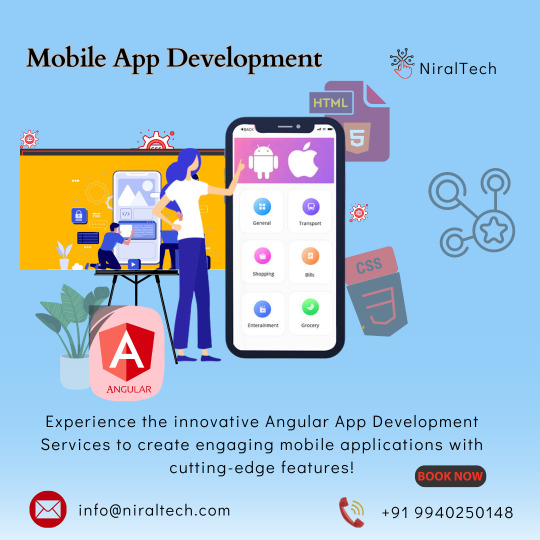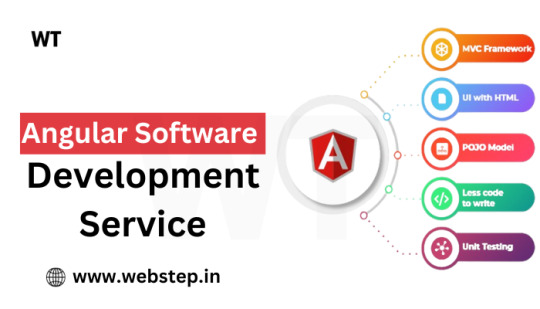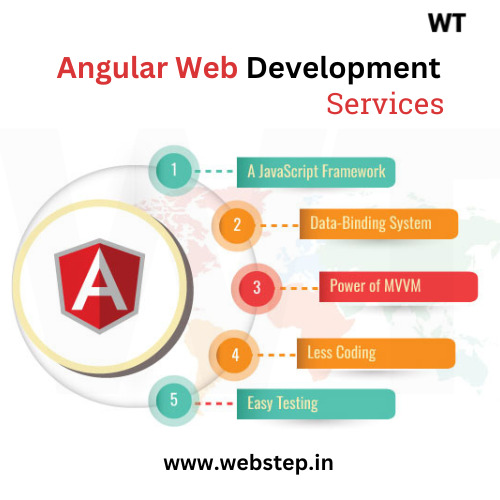#AngularApps
Explore tagged Tumblr posts
Text
"Explore our innovative Angular App Development Services to create engaging mobile applications with cutting-edge features! 📱💡 Let's bring your ideas to life."#AngularDevelopment #MobileAppDevelopment #Innovation #AppDevelopment #AngularApps #TechSolutions #CuttingEdgeTech #NiralTech

#AngularDevelopment#MobileAppDevelopment#Innovation#AppDevelopment#AngularApps#TechSolutions#CuttingEdgeTech#NiralTech
0 notes
Text
Angular Software Development Service

In the ever-evolving digital landscape, the role of a robust web presence cannot be overstated. As businesses strive to carve their niche in the online sphere, technology becomes the driving force behind success. Angular, a dynamic front-end framework, has emerged as a cornerstone in web development, offering a plethora of opportunities for businesses to elevate their digital presence. In this comprehensive article, we will explore the intricacies of Angular Software Development Services and unravel the transformative potential they hold for your digital journey.
Understanding Angular Software Development:
Angular, developed by Google, is not just a framework; it’s a powerful tool for crafting dynamic and responsive single-page web applications. At its core, Angular is known for its modular architecture, two-way data binding, and dependency injection, making it a preferred choice for developers aiming to create scalable and efficient user interfaces.
Key Features of Angular Development Services:
Modularity and Reusability:
Angular’s modular structure empowers developers to break down complex applications into manageable and reusable components. This modularity not only enhances code organization but also promotes reusability, allowing for more efficient development cycles.
Two-Way Data Binding:
One of Angular’s standout features is its two-way data binding. This real-time synchronization between the model and view ensures that any changes in the user interface are instantly reflected in the underlying data model, providing a seamless and dynamic user experience.
Dependency Injection:

Advantages of Choosing Angular for Your Project:
Cross-Platform Development:
Angular supports the creation of cross-platform applications, ensuring a consistent and engaging user experience across various devices. This flexibility is crucial in today’s multi-device landscape.
Community Support:
With a vast and active community, Angular receives continuous updates, ensuring your applications stay relevant, secure, and in tune with the latest industry standards. Community-driven support also means quicker issue resolution and access to a wealth of resources.
Optimized Performance:
Angular’s ahead-of-time (AOT) compilation translates templates into highly efficient JavaScript code, contributing to optimized performance. This results in faster loading times and a snappy user experience, factors critical for retaining user engagement.
The Transformative Impact of Angular Software Development Services:
Enlisting Angular Software Development Services for your projects opens the door to transformative benefits:
Scalability:
Angular’s modular architecture allows for the development of scalable applications, ensuring your digital solutions can adapt and grow alongside your business.
User-Centric Experiences:
Angular facilitates the creation of immersive and user-friendly interfaces, fostering positive user experiences that are crucial for customer retention and satisfaction.
Accelerated Time-to-Market:
The modular nature of Angular expedites the development process, resulting in quicker time-to-market for your applications. This agility is a significant advantage in today’s fast-paced business environment.
Conclusion:
Elevate your online presence with Webstep Technologies’ Angular Software Development Services. Our seasoned developers understand the nuances of this powerful framework, poised to turn your digital vision into a reality. Experience digital transformation and unlock the full potential of Angular. Contact Webstep Technologies to thrive in the digital era with tailored Angular solutions.
#AngularDevelopment#AngularServices#AngularApps#AngularDeveloper#AngularJS#AngularDev#AngularFramework
0 notes
Text

Python experts atNextBigItuse Python libraries and combine them with the experience to create the most flexible, simple, progressive and versatile apps for you.
https://nextbigit.com/python-development-services Call Us: +91 999 926 6766 Email Us: [email protected]
#PythonDevelopment#AngularApp#Development#FlutterAppDevelopment#appdeveloper#mobileappdevelopment#java#webdeveloper#coding
0 notes
Photo

Angular is more advanced than AngularJS in every aspect in terms of speed design, performance, and structure. AngularJS code does not support mobile apps, and this could be the most significant benefit Angular can offer over AngularJs.
Here find out more about the upgrading from AngularJs to Angular, visit http://bit.ly/2UwLy7D
0 notes
Photo

👉 Follow @the.rezourze for more daily updates. Top 5 Angular Mobile UI Framework Resources to Create Apps Get top Angular Mobile UI Frameworks from rezourze.com, here you can get the topmost mobile UI frameworks for your projects. rezourze.com examines and provides you the best frameworks for your mobile application and helps you to reduce your time. To See More Angular Mobile UI Frameworks Use The Link — http://bit.ly/2LXz7hM 🎁 Don’t forget to save. 💕 Double tap to show some love! 💡 Get notified, tap the triple dots on the top right “…” and click ‘Turn Post Notifications On’ ⭐️ Want to get featured? Use @the.rezourze and tag us! 👉follow @the.rezourze 👉follow @the.rezourze 👉follow @the.rezourze 👉follow @the.rezourze Your comments are welcome here👇 #angular #angularjs #angulardeveloper #angularmomentum #oxalistriangularis #angular7 #angular6 #angularmaterial #angular2 #angularjsdevelopment #angular4 #mobileappdevelopment #mobileappdesign #frontenddeveloper #frontenddevelopment #frontenddesign #angularui #angularmobileappdevelopment #angularmobileappdevelopmentservices #angularapp https://www.instagram.com/p/CJMMUybBjIv/?igshid=ulo5bcgrzw8m
#angular#angularjs#angulardeveloper#angularmomentum#oxalistriangularis#angular7#angular6#angularmaterial#angular2#angularjsdevelopment#angular4#mobileappdevelopment#mobileappdesign#frontenddeveloper#frontenddevelopment#frontenddesign#angularui#angularmobileappdevelopment#angularmobileappdevelopmentservices#angularapp
0 notes
Photo

Dive into the world of mobility with your unique ideas transforming into incredible apps for your business requirements.
Contact Us
📞 : +91 9496 369 416
0 notes
Photo

Angular FAQ...
0 notes
Text
Upgrading your AngularJS application to Angular
I am a full stack developer which, for quite a long time, meant for me working mainly on the back end part of the application and touching the front end only to either reuse some components prepared by the front end team, or to make, let’s call it, a dummy view and… well you guessed it leave it for the front end team to make it more sensible. Back then I was living a joyful life not really caring about all the frameworks, bundlers and other stuff used to make the app’s appeal. But nothing lasts for ever and finally, due to some staff rotation (that’s a great euphemism), I was maintaining and developing pretty much everything, which obviously included also the dreaded front.
Since now I was sort of in charge I thought it would be a great idea to at least try to modernise everything that could be modernised. As the app predates Angular it was developed mainly in AngularJS (actually it was a mixture of many different technologies - I guess every programmer working on the code added something that excited him at that moment, leaving really diverse environment) so my best idea was upgrading it to… Angular.
In this post I’ll try to explain what I actually did, how you can upgrade your app from AngularJS to Angular, how to use Angular components within AngularJS components and vice versa and how I resolved routing issues.
It begins with a simple step
Actually there are many articles and posts on upgrading AngularJS to Angular (e.g. Victor Savkin’s Migrating Angular 1 Applications to Latest Angular in 5 Simple Steps). Also the official Angular documentation can be of use. I am not a pioneer here, but I have some experience in upgrading actual application.
First thing you will discover when you start digging is that you don’t really need to upgrade old code to upgrade your app. Angular provides UpgradeModule which is an NgModule allowing you to transform your app into a hybrid running both AngularJS and Angular code.
Simple, right?
Well… if you are lucky enough and the structure of your AngularJS code is… structured (i.e. you’ve got your components, directives, controllers, services and factories imported and declared in modules that are exported and then further imported in parent modules all the way down to the root module) without any quirks and other exotic features then you are ready to go. Otherwise you need to work on that first.
Next step is creating an Angular app - root module will be sufficient for start:
import {NgModule, Component} from ’@angular/core’; import {BrowserModule} from ’@angular/platform-browser’; import {UpgradeModule} from ’@angular/upgrade/static’; @NgModule({ imports: [ BrowserModule, UpgradeModule ], bootstrap: [AppComponent], declarations: [AppComponent] }) export class AngularAppModule { constructor(public upgrade: UpgradeModule) { } }
It is important not to forget to inject UpgradeModule in constructor as it does most of the magic!
And finally bootstrapping:
import {platformBrowserDynamic} from ’@angular/platform-browser-dynamic’; import {AngularJSAppModule} from ’./angular-js-app’; import {AngularAppModule} from ’./angular-app’; platformBrowserDynamic().bootstrapModule(TaxCubeNg2Module).then((ref) => { ref.instance.upgrade.bootstrap(document.body, [AngularJSAppModule.name]); });
With the above code the AngularJS application will be bootstrapped within the Angular application and both apps will run in parallel. Especially in case of big applications this is a great starting point as you don’t need to rewrite entire code to enjoy features of the newer framework and migrate your old code gradually (or even leave it as is).
Steep route
Of course this isn’t the end of the story. Not yet at least. The first issue I had after bootstrapping both apps (except for bundling it, but bundler’s configuration is a material for a different post, as it was specific for some choices that were made in terms of bundler itself and some configurations and optimisations made in the past) was fixing routes as no matter what address I typed in the browser it was always redirecting me to the AngularJS landing site in the best case scenario only flashing Angular view for a brief moment.
In general, if you create a hybrid app, at least for some time you are condemned to use two routers, i.e. UI-Router and @angular/router, which means that in the content section of your app (and maybe in some sidebars, headers and footers) you’ll have those two one right next to another:
<div class="content-section"> <div></div> </div>
Most of the articles suggests here creating a routing handling strategy and providing it in your Angular root module (routing handling strategy is a small class implementing UrlHandlingStrategy which, when provided, tells Angular’s router which of the URL’s should it support). This maybe useful as you don’t really need both of them to work at the same time but actually it didn’t fix the problem I came across. No matter what I typed into my routing handling strategy it didn’t exactly gag UI-Router. It was like one of my exes, it always wanted to have the last word and always when it got URL not matching its resources the sucker redirected to the landing site before the handling strategy even kicked in.
The solution to the above was actually a very simple trick, although as usually in such a cases I spent tons of time reading more and more articles and Stack Overflow threads and adding to my code couple dozens of lines to no avail. What I finally did was adding a new state in my $stateProvider in configureRoutes() function. I named it “ng2″ and added an empty template as the content view:
$stateProvider.state("ng2", { views: { "content@": { template: "" } } })
Moreover for the $urlRouterProvider I created custom otherwise function which redirected all the Angular app’s URLs to that state, showing nothing in ui-view and keeping UI-Router on the leash:
function otherwise($injector, $location) { $injector.invoke(["$state", ($state) => { const url = $location.url(); if (url === "" || url === "/") $state.go("main.app.home"); else if(url.toString().toLowerCase().includes("/AngularApp")) $state.go("ng2"); else $state.go("main.app.notFound"); }]); }
Upgrade - using AngularJS elements within the Angular code
So far I found three different cases of using AngularJS elements within my Angular code:
Simple one
If your directive or component is just a tag and you don’t need to pass any properties, e.g. you don’t bind to it any variables or functions then just use it as you’d do it in your AngularJS code, simply add the said tag in the HTML code. You’ll need also to add the
CUSTOM_ELEMENTS_SCHEMA const to your @NgModule schemas section, so Angular knows that you are using elements that weren’t explicitly declared, but that’s pretty much all you need:
@NgModule({ schemas: [ CUSTOM_ELEMENTS_SCHEMA ] }) export class AngularModule { }
Upgrading directives and components
Here it gets slightly more complicated. Angular cannot communicate directly with AngularJS elements so you’ll need to create a wrapper translating what you want to achieve to concepts better understood by Angular. Provided that your AngularJS directive looks something like this:
function angularJSDirective() { return { // ... scope: { firstInput: ">", secondInput: ">" } } };
You’ll need to create an Angular @Directive extending UpgradeComponent class:
import { Directive, ElementRef, Injector, Input } from '@angular/core'; import { UpgradeComponent } from '@angular/upgrade/static'; @Directive({ selector: 'upgraded-directive' // selector which you'll use in your HTML }) export class UpgradedDirective extends UpgradeComponent { @Input() firstInput: any; // possible be specific type @Input() secondInput: any; constructor(elementRef: ElementRef, injector: Injector) { super('angularJSDirective', elementRef, injector); } }
If you declare the above wrapper in your @NgModule you can use it like any other Angular directive.
The only catch here is that sometimes your AngularJS elements are dependant on AngularJS objects, e.g. $scope. This can be resolved by creating and declaring providers, e.g.:
export const ScopeProvider = { deps: ['$injector'], provide: '$scope', useFactory: ($injector: Injector) => $injector.get('$rootScope').$new(), };
Services (providers)
Similarly to the $scope provider mentioned above you can create wrappers for any of your AngularJS services.
const AngularJSProvider = { deps: ['$injector'], provide: 'angularJSService', useFactory: ($injector: Injector) => $injector.get('angularJSService'), };
Than declare it in the @NgModule in which you want to use it:
@NgModule({ providers: [ AngularJSProvider ] })
And simply inject it in the constructor.
constructor(@Inject('angularJSService') private angularJSService) { }
Downgrade - using Angular elements within the AngularJS code
In case of downgrading Angular elements the things are even simpler. You can use downgradeInjectable function and declare its result as a factory in the AngularJS module where you need it. Than use it as any other AngularJS service.
import { AngularService } from '/angular-modules/.../angular-service.service'; export const angularJSModule = module("angularJSModule", [ /*...*/]) //... .factory("angularService", downgradeInjectable(AngularService) as any);
I hope you enjoyed reading this post and it proved to be at least somewhat useful to you.
If you have any questions, comments or remarks regarding the above the comments section is yours.
0 notes
Video
Angular 9 Tutorial: Part 16 - Input Keyboard Events
0 notes
Link
In this course, you will learn how to design a complete Map that allows you to add markers from scratch. The Map will allow you to add locations using latitude and longitude, as well as by simply clicking on the location on the map.
0 notes
Text
PHP Laravel Development
NextBigIT best PHP Laravel Development Company based in India providing Custom Web application Development services. Hire our Laravel developers for scalable, customized, and feature-rich web applications.

#PHP#Laravel#PHPDevelopment#LaravelDevelopment#PythonDevelopment#AngularApp#Development#FlutterDevelopment
0 notes
Text
How to resolve "core_1.PriorityQueue is not a constructor" in angular when creating a component or module
How to resolve “core_1.PriorityQueue is not a constructor” in angular when creating a component or module
If you are generating angular component or module from angular cli using command ng g m [module name] and you get the error trace as below
TypeError: core_1.PriorityQueue is not a constructor at new TaskScheduler (E:\angularapp\node_modules\@angular-devkit\schematics\src\engine\task.js:20:23) at SchematicEngine.createContext…
View On WordPress
0 notes
Photo

Angular Quiz of the Day...🤔❓❓❓ #Quiz Test your Angular knowledge, Try to find the Correct Answer .
.
.
0 notes